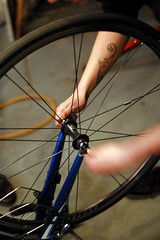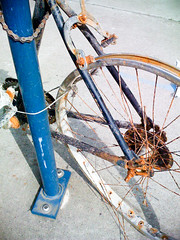
(Photos © J. Maus)
Editor’s Note: This article was written by guest author Tori Bortman. Tori is very active in the local bike scene. She’s a co-host of the KBOO Bike Show, a promoter of bike polo and women-only alleycats, and she’s the proprietor of her own bike mechanic training business, Gracie’s Wrench (which we reported about two years ago and was featured in The Oregonian this past Sunday).
Today she shares a few tips about how to coax your battered bike (and psyche) out of the winter doldrums and into the sunshine ahead!
In the past few days the undeniable signs of upcoming warmth and sun are here. The green sprouts of leaves carpeting tree branches. Crocuses and daffodils. The sweet song of the first robins to return from the south and the lengthening days thick with lazy twilight. Wait. What’s that other sound?
Ahem… I believe that’s your bike.
Is it whispering to be let out from the basement or garage into the warm sun? Or maybe that’s the whining shudder reminding that winter’s rain and road grit have not been so kind? Spring cleaning can bring some fresh perspectives, so here are a few ways to show your bike some love and start the season off right.
“Sometimes it’s the little details that make the biggest difference.”
— Tori Bortman
Start by clearing your rims with a clean, dry rag (avoid cleanser as fluid will smear the schmutz) to remove all the pumice-filled road grime and brake dust. This will increase power and quiet your brakes. Remove your wheels and scuff up the surface of your brake pads with emery cloth, a file or sand paper to ensure any build-up doesn’t transfer back to the rim surface.
We can all appreciate looking spiffy, so while your wheels are off take the opportunity to clean off your frame with a light cleanser and rag. Avoid washing your bike with a hose or lots of water that can get into bearings and wash the valuable grease away. Be sure to floss between the nooks and crannies that might not usually get your attention. Sometimes it’s the little details that make the biggest difference.
Use some WD-40 or other solvent (like Citrisolve) sprayed onto a rag to clean the old grime off your chain. Run the chain through the rag instead of spraying the chain directly as it can leave a residue that will ruin the fresh oil you apply after cleaning. Warning! WD-40 is not used as a lubricant but as a cleanser and is in no way a replacement for properly oiling your chain. After cleaning and thoroughly oiling your chain be sure to run a rag over it again to keep from attracting any new dirt—one of the most important steps, never to be skipped! If you’re riding regularly this is can be a weekly ritual that gives you a chance to look things over on your bike.
Inflate your tires to the highest side of the recommended range imprinted on the sidewall of the rubber. Surprisingly, this combined with oiling your chain can often make your ride feel brand new.
Next, your helmet. It’s not actually part of your bike but shouldn’t be overlooked. Check for any cracks in the plastic or foam. Most helmets break down in three to five years (sometimes less) and will need to be replaced. Damaging UV rays along with accidental drops and bumps while you’re not wearing it can add up.
As you roll out into that sunshine take notice of your bike as you ride. Do the brake levers pull all the way to the handlebars when you stop? Does your bike not want to shift without coaxing? Are there any strange rattles you’ve just gotten used to? If you answered “yes” to any of the above it might be time to take your bike into your favorite shop for some professional service. Or maybe this spring will be the time to grow your knowledge with a bike maintenance class. Either way, enjoy the strengthening sun on your skin, the spring breeze (chilly as it may be), and the cherry blossoms promising winter’s end.









Thanks for reading.
BikePortland has served this community with independent community journalism since 2005. We rely on subscriptions from readers like you to survive. Your financial support is vital in keeping this valuable resource alive and well.
Please subscribe today to strengthen and expand our work.
Would’ve been a good idea to mention the ABC Quick check. http://www.bikeleague.org/resources/better/beginningcycling.php
It is a big myth that you need to replace your bike helmet every so many years.
One more thing: consider washing your helmet straps now and then in some warm water with a mild soap. (The straps collect oils from your skin and dirt and dust from riding that wear back into your skin.)
Great article! I always need gentle prodding to give my bike the TLC it deserves. Tori has a great readable style – let’s have more from her!
Joe-
If you have seen numerous aged helmets, you would know it is not a myth.
Great and helpful post, by the way. Thanks Tori!
RE: helmets
funny you mention this Tori… I just noticed some huge and major cracks in my helmet this morning… and i have never had a major crash with it. must just be getting old… time to call a few old industry friends at Bell/Giro ;-).
I definitely need to give my bike a good once over with a cloth and clean out the insides of the fenders and chain case. It’s been a number of months since cleaning and oiling the chain, but it’s not squeaking or anything yet. One very nice thing about hub brakes, no cleaning necessary.
Incidentally, anybody giving free/cheap classes on truing wheels? My front wheel could use a bit of work, and it’s something I’d love to learn.
What about supporting the local shops? Can anyone give J.M. a discount?
Joe-
Be our own MythBuster. I (and I am sure others) would like to hear the reasoning and evidence behind your assertion.
Re HELMETS:
http://www.bhsi.org/standard.htm
The most important thing is to be sure the straps and the clasp are fully functional.
The shell and foam must withstand four heavy hits to pass US standards for sale.
Tori’s done many wonderful things, and I normally enjoy her writing. But today, alas, that enjoyment is slipping a bit.
Her advice is good, if you’ve got the same type of bike she does. Maybe I’m just being a little overly sensitive, but I’m just a tad irritated at the way she blithely assumes every bike is the same as hers.
She could have written something along the lines of “If you have these types of brakes, here is what you should do for the rims and brake pads.” I’ve got internal hub brakes, so her advice is not so relevant.
Similarily, she could have written “If you don’t have internal hub gears and a full chainguard, here is what to do with all the road grime on your chain.”
And again she could have written “If you’re doing stunt jumping or some other extreme activity so you’re using a bike helmet, here is how to maintain it.”
That little word “if” goes a long way to help people feel included. Ironically enough, the Bakfiets in the photo is a lot more like my bike (Dutch and all) than hers.
Kevin-
‘If’ you lightened up a bit you just might…
The league of american bicyclists “ABC Quick Check” makes good sense, especially with the popularity of older road bikes getting continued use.
I am commenting especially on the Quick release check as part of the daily checklist. Older bikes,before a certain age ( ~ 1990 or so ) did not have devices to prevent a front wheel from accidently coming loose, ( commonly referred to as ‘lawyer locks’). Hence, a loose quick release sometimes ended tragically. I speak from experience.
It only takes a few seconds to check things out. Or you might regret your lack of checking for a long,long time.
btw.. the helmet wearing out arguement going.. everything..everything wears out,sooner or later. IF you understand the value of a helmet, dont be afraid to regularly replace them. If you don’t belive in helmets, I cant tell you anything.
Kevin:
If I see something that doesn’t apply to me, I usually just ignore it.
If I see someone giving generally useful advice, I’m grateful they took the time to do a writeup.
If someone tries to do a good deed, I’d like to think that sometimes it *will* go unpunished.
What?! There are people who stopped riding for the winter??? And you guys call yourselves cyclists!
the horror.
I laugh at fair-weather riders. But welcome back, anyway. 😉
I printed this out to hang in the company bike locker for the year’s fair-weather riders.
Kevin-
I think the vast, vast majority of bicyclists here don’t have internally geared hubs or brakes. Her article was useful for all those people with accessible chains and rim brakes whose dirty, squeaking bikes could use a little TLC, especially in hard times when people probably can’t afford to take their bike to a shop to be detailed. Lighten up a little.
Wipe out the inside of yer fenders. After the crud dries out it will get shaken off on a bumpy ride and wind up right back in yer brake pads and all over thse freshly spit shined wheels. I speak from expirience!
Thanks Tori, for taking the time to write a nice reminder, etc. I’m “married” to a mechanic….so i see it all/hear it all.
regarding helmits….kids helmits get dropped a LOT…. i noticed my daughters 1 year old helmit with cracks in it. We commute daily, so i’m willing to spend the $30 for another helmit….worth saving my daughters precious head.
i actually have several helmits for my daughter….ie. fun ones make riding fun (especially when it’s 20 degrees, and riding to school is a drag)
in regards to not including “all” maintenance advice….this was an article, not a manual. Hey, i saw this as a reminder and quick list of things to remember to look at. Good reminder about WD-40…. another reminder…..if you don’t have a chain checker, go to your LBS and ask the mechanic to check your chain, to see if it needs to be changed. Typically they need to be changed every 1000 (or so miles). If you’re commuting, those miles add up. having a stretched out chain can mess up your drive train….which is costlier than a chain. It’s a wear item, that so many non-regular/regular riders don’t seem to change.
Another nice thing about an internally geared rear hub – chain a bit loose? just nudge the wheel back in the dropouts, 5 minute job 🙂 The chain stretches a bit naturally from new condition, so it’s normal to have that happen a bit.
1. Tori — how do you rock? Lemme count the ways. Thanks for reminding all of us to love our bikes a little more regularly.
2. @NB (#18):
“I think the vast, vast majority of bicyclists here don’t have internally geared hubs…”
Check out bike racks all over inner eastside and downtown Portland. I have run out of fingers regularly to count how many old three-speeds there are still rolling in this town.
Happy riding! –Beth
…or new 3-speeds.
and I have a feeling there are going to be more and more new internally geared hubs coming up in Portland…
@Beth (#22)
I’m sure there are plenty of old Stumey Archer hubs floating around – certainly, I see old Raleigh 3 speeds too. But the *majority* of people are riding bikes with exposed gears and chains and brakes, and all I was saying was for that Kevin dude to chill out when Tori’s article is a brief summary of ways to spring clean your bike. This was a helpful article, not some sort of faction war. (If you 3-speeders are insulted by this for some reason, wait for someone to post something about how her article didn’t cater to fixie riders who don’t *have* brakes: “How do you expect me to clean brakes that aren’t on my bike!!!”) Sheesh people, lighten up.
It’s true, most people in Portland are riding bikes with exposed brakes and gears, so this article does cater to most people in Portland.
I was a bit surprised that this would be offensive as well. Then again, people do get a bit bike class-ist (see discussion on eBike store) 🙂
I think there are certain benefits to certain types of bikes, but they’re all bikes, and I’m glad they’re out there.
I recommend the local company Nutcase for some really snazzy helmets! Jonathan, one of those would be stylin on you!